| Author |
Message |
|
Pedro Trigueiro
|
 Posted: Sat 13 Aug, 2016 5:04 pm Post subject: Gendarmes, horse barding and the Battle of Pavia Tapestry. Posted: Sat 13 Aug, 2016 5:04 pm Post subject: Gendarmes, horse barding and the Battle of Pavia Tapestry. |
 |
|
I created this topic mostly based on some of my observations of the gens d’armes seen in the pavia tapestry. As such, I feel that the most important question would be: Is the Battle of Pavia Tapestry an accurate representation of arms, armor, etc. of the period? This questions sounds a bit specific, but I imagine it’s still very important to the topic. Anyways, I see no reason not to trust the tapestry.
Here's the tapestry link, its way too heavy to attach:
http://www.riha-journal.org/articles/2014/gal...des/fig.-1
The observations I made are that, based on what I can see from the tapestry, horse armor for the gendarme cavalry varies a lot. But overall it isn’t very prevalent and even those individuals which do have armored horses, usually still leave some areas unprotected.
There’s some examples of chanfrons, crinets (here I want to make another observation, all the crinets I’ve seen on the tapestry cover the mane, but I can’t see any examples of the neck itself being covered), peytrals and very few cruppers. All in all, while the riders are certainly very well armored, the horses vary a lot, with some being armored to varying degrees and others being not armored at all.
I think this view of the absence of horse barding would make sense based on one quote I found in the “Gendarmes, The Italian wars and more [Newcomer]” thread by Benjamin H. Abbott:
“You might want to read Instructions for the Warres (1548) by Raimond de Beccarie de Pavie, baron de Fourquevaux - usually shorted to just Fourquevaux, because that's a long name. Fourquevaux was a young teenager when Bayard fell in 1524. He gave a detailed description of how he wanted men-at-arms to arm themselves and fight. He wanted them to each have a lance of reasonable length, so he's not much help there, a sword - also not specific - and a mace. He wrote that a proper harness for a man-at-arms should be complete and that it would defend against basically everything except guns and artillery. He did note that harness might stop a arquebus ball at distance or if the gun were poorly charged or overheating. He wanted considerable horse armor for his men-at-arms and instructed them to avoid aiming their lances at their opposing armored counterparts and instead target the horses, which apparently rarely wore much barding at that time. Once the men-at-arms took to their swords, they were to continue to target the horses or any unarmed spot the found of the men. ”
Now the quote by Fourquevaux :
“In the meane while the enemie his men of armes do charge ours as much as the horses can runne, but marke well the man|ner of our men who stand still to receiue them. But assoone as the Captaine generall his Trompet doth sound, they do runne all at once: although the rase be not aboue twentie or thirtie pa|ces. And this they haue done (as I think) to resist their enemies the more forciblie. Haue you seene how our men of armes haue with their Launces galled the enemies horses in their breastes and sides? being sure that the enemies could neither hurt their persons nor their horses, because that they are very well armed themselues, and their horses are barbed and garnished with Chamfrings and Criniers, which the enemies do want: which is the cause that you do see so many of the enemies slaine, and so fewe of ours. Marke how our men with the force of their hor|ses, and with the thrustes of their swords do repulce their ene|mies, killing their horses as long as they may, & laying on vpon the men at all places where they may finde them vnarmed. The mase doth his office there also, and the Captaine Generall of the horsemen doth commaund the men of armes to keepe them selues firme together, and not to breake their rankes, or to suffer their enemies to enter within them by any meanes.”
So, anyone knows about this subject? Maybe horse barding gradually declined in the 16th century? Or maybe not every gendarme could afford full barding for their horses?
Lastly, I want to ask. Does anyone have any idea why the neck region is usually so exposed? Even in depictions where the gendarmes clearly have almost fully armoured horses, the neck region is usually left exposed. Take these examples:
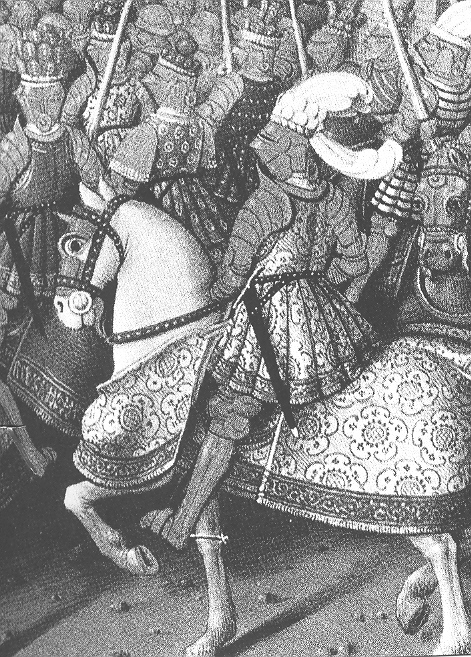
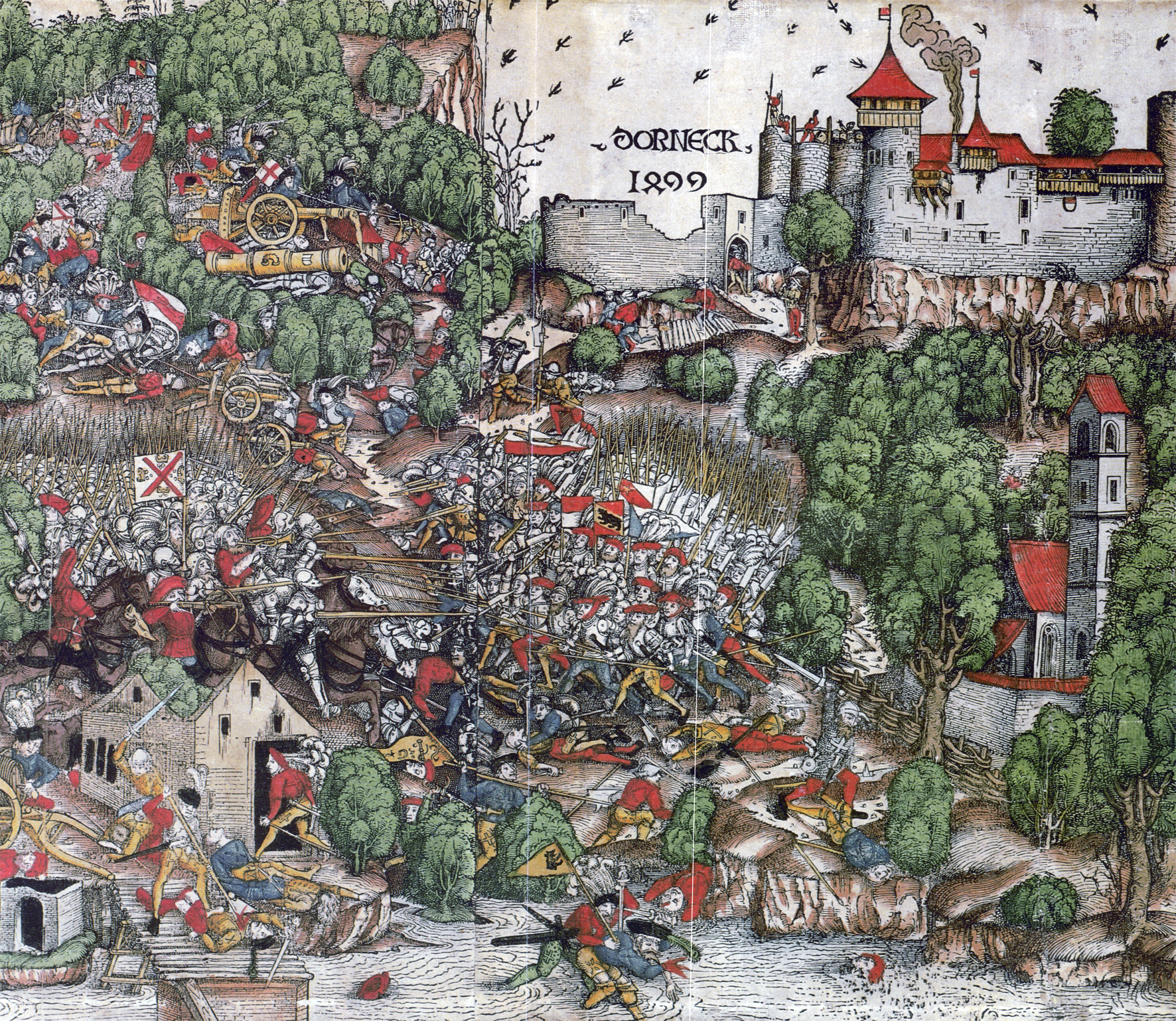


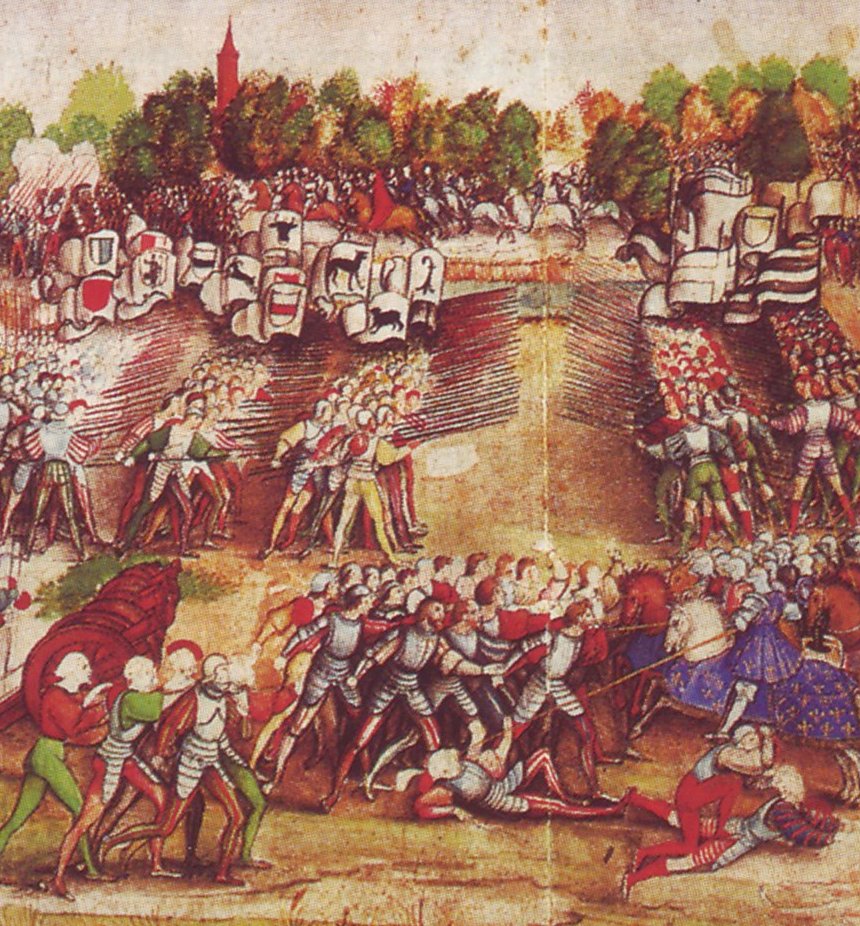
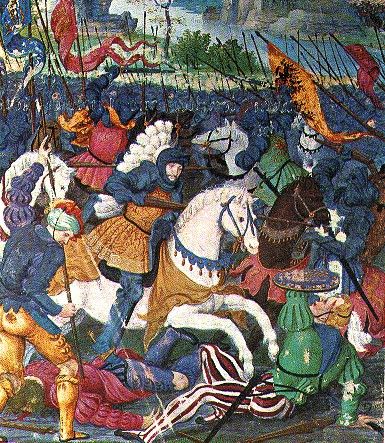
Why should that be? Is armor for the neck area too expensive? Or maybe it restricted the horse’s mobility? Because I find it quite weird, that an area that would be so exposed to lances, pikes, crossbow bolts, etc. would be mostly unarmored.
|
|
  |
 |
|
Philip Dyer
|
 Posted: Sat 13 Aug, 2016 7:57 pm Post subject: Posted: Sat 13 Aug, 2016 7:57 pm Post subject: |
 |
|
|
I would guess that is has to with horse response to commands. If my understanding of basic equestrian ship is correct, orders to turn are signaled to by bit pressure, sideways yanking of the head, pressure from the reins on the neck, and pressure from the feet. Cutting either one of these command signal systems would make the horse less responsive and that can back the difference between life or death for the mount and/or as much or more than having the horse a large squishy target. Heavy cavalryman's horses needed to be as close to the horseman's feet as far as controllability as possible.
|
|
  |
 |
Tom King

|
 Posted: Sat 13 Aug, 2016 8:09 pm Post subject: Posted: Sat 13 Aug, 2016 8:09 pm Post subject: |
 |
|
In the 16th century proper, the proliferation of firearms.
Also cost vs result/tactical inflexibility; the same reason why the lancer who'd utilize horse barding declined during the same period.
You were much more likely to see reiter's on the renaissance battlefield with pairs of pistols or carbines, half armors, swords, and unbarded horses.
|
|
  |
 |
|
Pedro Trigueiro
|
 Posted: Sat 13 Aug, 2016 9:03 pm Post subject: Posted: Sat 13 Aug, 2016 9:03 pm Post subject: |
 |
|
| Philip Dyer wrote: | | I would guess that is has to with horse response to commands. If my understanding of basic equestrian ship is correct, orders to turn are signaled to by bit pressure, sideways yanking of the head, pressure from the reins on the neck, and pressure from the feet. Cutting either one of these command signal systems would make the horse less responsive and that can back the difference between life or death for the mount and/or as much or more than having the horse a large squishy target. Heavy cavalryman's horses needed to be as close to the horseman's feet as far as controllability as possible. |
Interesting... Unfortunately i lack knowledge on horsemanship to discuss this in-depth, but im still not exactly sure. Cavalry with full horse barding existed before, so i wonder if horse armor would really be this much of a hinderance?
| Tom King wrote: | In the 16th century proper, the proliferation of firearms.
Also cost vs result/tactical inflexibility; the same reason why the lancer who'd utilize horse barding declined during the same period.
You were much more likely to see reiter's on the renaissance battlefield with pairs of pistols or carbines, half armors, swords, and unbarded horses. |
Im not sure about some of the points you make in your post.
About the proliferation of firearms, was barding even popular before it? At least looking at art from the 15th century it doesnt look so for me:




About the decline of the lancer, the period im talking about is mostly early 16th century, though i guess later 16th century could also counts. From what i know, firearms did indeed influence their decline, but thats was mostly because of pistol armed cavalry engaging lance armed cavalry in the french wars of religion? Gordon Frye has a pretty good article on this.
Also have to disagree with the bit on it being much more likely to see reiters, for the later 16th century sure. But for the earlier period? Men at arms seen to have been employed by plenty of armies during it.
Anyway, i think this is getting a bit off topic. I wanted to focus more on the barding aspect, not so much on if gendarmes were becoming obsolete(which i believe happened mostly when pistol armed cavalry drove them out of the field) or not.
|
|
  |
 |
Tom King

|
 Posted: Sat 13 Aug, 2016 10:34 pm Post subject: Posted: Sat 13 Aug, 2016 10:34 pm Post subject: |
 |
|
Your first image "John of Gaunt being received by the citizens of Bayonne" shows a plain clothed herald with an unbarded horse and his retinue, drawn about 200 years after the fact. The third shows armored horses in the background and the 4th "King Edward III of England Crosses Somme Before Battle of Crecy" shows mounted archers on the left, also drawn ~200 years after the fact.
We know cloth bardings and horse armor were common during the middle and high middle ages, as well as common amongst lancers in the renaissance period. Most of these, artistically would be grey on grey on grey on grey or "monotone blob with guy on it" if the horses were drawn with bardings. Art is generally a terrible source for discerning arms and armor. Funerary effigies and some of the surviving fechtbuchs and campaign journals paint a more accurate picture before we get into the renaissance proper with the use of perspective, foreshortening, and contrast to paint people (and arms) photorealistically.
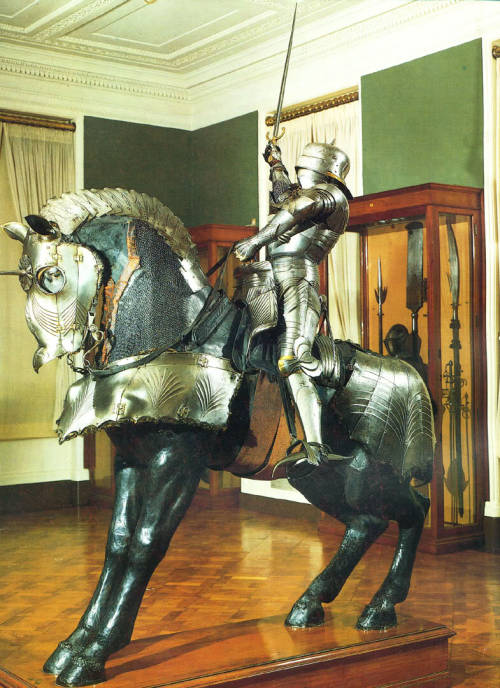
maile, which is exceeding rare to find in any identifiable form, would be used to guard a horses neck if armor wasn't forgone.
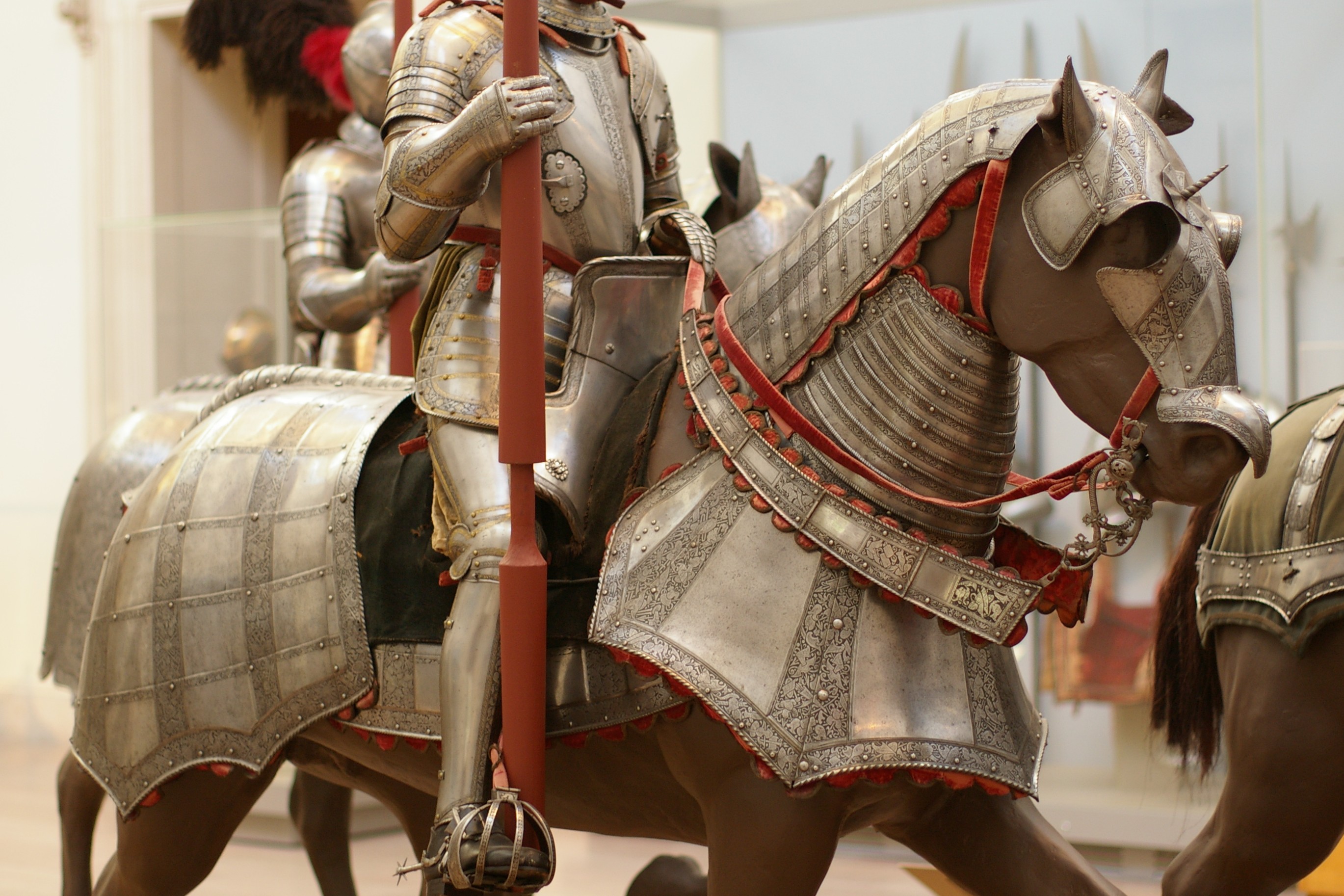

but we have surviving horse bardings from the end of the late middle ages/early renaissance that provide plate defense.
We know as early as edward the 1st in England at least a man at arms would need to possess a barded war horse to be paid as such.
this link
The reason why I bring up firearms is that in your initial question about the battle of Pavia, firearms were quite prevalent. It occurred in 1525. A shot proof Peytral and chaffron is about the most you'd expect for a lancer, let alone demilancer.
|
|
  |
 |
|
Mark Griffin
Location: The Welsh Marches, in the hills above Newtown, Powys. Joined: 28 Dec 2006
Posts: 802
|
 Posted: Sun 14 Aug, 2016 2:33 pm Post subject: Posted: Sun 14 Aug, 2016 2:33 pm Post subject: |
 |
|
| Quote: | | If my understanding of basic equestrian ship is correct, orders to turn are signaled to by bit pressure, sideways yanking of the head, pressure from the reins on the neck, and pressure from the feet. |
Sorry, all either wrong or only partially correct. Some generalizations below.
1. Bit Pressure. You need to maintain contact and yes a tiny bit of signalling can be done with the mouth but thats primarily your braking system, coupled with weight movement in the seat. Lean forwards go, lean back stop or dont go.
2. Yanking the head. Totally not. If you do that your horse wont be your friend for very long and your fellow riders will treat you with the contempt you deserve.
3. Neck reining. Yes, probably the principle reason why barding isn't on many horses. But not entirely necessary and of course we have solid plate defenses for the neck so that negates neck reining as a method of control.
4. Pressure from the feet. I know where you are coming from but its way more complex than that. If you were simply to squeeze with your feet you might get an unpleasant surprise.
When riding in this style you are controlling the horse by pretty much every movement of your body. Its stupid complex and takes a heck of a lot of practice and hard work but your seat, coupled with your shoulder, torso, hip and all your leg doing subtly different things.
Basically, riding in full metal barding means you are working purely from the body, nothing to do with the reins really, you are flexing yourself and the horse is turning with you, feeling how you are turning. Yes controlling the head is an important part, but its not just pulling at the reins.
Plenty of melee videos on you tube. If you are in the UK some of the best European 'knights' are about to do them this week and next for English Heritage at Carisbrooke Castle.
Currently working on projects ranging from Elizabethan pageants to a WW1 Tank, Victorian fairgrounds 1066 events and more. Oh and we joust loads!.. We run over 250 events for English Heritage each year plus many others for Historic Royal Palaces, Historic Scotland, the National Trust and more. If you live in the UK and are interested in working for us just drop us a line with a cv.
|
|
  |
 |
|
Philip Dyer
|
 Posted: Sun 14 Aug, 2016 8:30 pm Post subject: Posted: Sun 14 Aug, 2016 8:30 pm Post subject: |
 |
|
| Mark Griffin wrote: | | Quote: | | If my understanding of basic equestrian ship is correct, orders to turn are signaled to by bit pressure, sideways yanking of the head, pressure from the reins on the neck, and pressure from the feet. |
Sorry, all either wrong or only partially correct. Some generalizations below.
1. Bit Pressure. You need to maintain contact and yes a tiny bit of signalling can be done with the mouth but thats primarily your braking system, coupled with weight movement in the seat. Lean forwards go, lean back stop or dont go.
2. Yanking the head. Totally not. If you do that your horse wont be your friend for very long and your fellow riders will treat you with the contempt you deserve.
3. Neck reining. Yes, probably the principle reason why barding isn't on many horses. But not entirely necessary and of course we have solid plate defenses for the neck so that negates neck reining as a method of control.
4. Pressure from the feet. I know where you are coming from but its way more complex than that. If you were simply to squeeze with your feet you might get an unpleasant surprise.
When riding in this style you are controlling the horse by pretty much every movement of your body. Its stupid complex and takes a heck of a lot of practice and hard work but your seat, coupled with your shoulder, torso, hip and all your leg doing subtly different things.
Basically, riding in full metal barding means you are working purely from the body, nothing to do with the reins really, you are flexing yourself and the horse is turning with you, feeling how you are turning. Yes controlling the head is an important part, but its not just pulling at the reins.
Plenty of melee videos on you tube. If you are in the UK some of the best European 'knights' are about to do them this week and next for English Heritage at Carisbrooke Castle. |
Thank you for info, corrections and explanations. I'll sure to watch some equestrian videos.
|
|
  |
 |
|
Ed W.
Location: New Zealand Joined: 27 Mar 2016
Posts: 42
|
 Posted: Sun 14 Aug, 2016 11:35 pm Post subject: Posted: Sun 14 Aug, 2016 11:35 pm Post subject: |
 |
|
Regarding the decline of cloth horse barding, art work from the early and high middle ages suggests a heraldric function as much as anything else. The lack of cloth bardings (caparisons) in later periods may reflect a more general decline in the relevance of heraldry on the battlefield.
Example below from http://manuscriptminiatures.com/4086/7885/

|
|
  |
 |
Pedro Paulo Gaião

|
 Posted: Tue 16 Aug, 2016 9:34 am Post subject: Re: Gendarmes, horse barding and the Battle of Pavia Tapestr Posted: Tue 16 Aug, 2016 9:34 am Post subject: Re: Gendarmes, horse barding and the Battle of Pavia Tapestr |
 |
|
Pedro, much of your images don't necessarily represent the French gendarmes, but noblemen as heavy cavalry; only the first and the fourth (perhaps also the third too) actually represent gendarmes. Seens that velvet covered barding was particular popular in Italy (becoming popular among the Gendarmes and the French King by the italian wars
But talking about horse barding, I remember the earliest reference to a full plate barding comes from around 1450, from Germany. I believe the reason why you don't usually see them are two:
1) This is pure speculation, but I think they're considerably more expensive than full plate armour in human shape. Probably armor-smiths spent more time and resources making armor in horse's shape rather than in human form. With less supply, the prices rise, making it accessible only to the more wealthy nobles.
2) Now we get more basis: Bardings makes horses slower and less efficient than a unarmored destrier. I remember seeing a picture (can not remember now whether it was a coin or a picture) of Emperor Maximilian I riding a horse with full plate bardings and two pairs of schynbalds to the animal's paws. It was a way of demonstrating imperial power through ostentation, but wouldn't be practical in battle field at all. I also remember that Reyes Católicos of Spain banned the use of horse bardings among their knights and men-at-arms (with a reason, of course)
By putting armor on a horse, you leave it slower. Leaving it slower, you decrease the impetus of its charge, making the charges less powerfull. That's why many byzantine chroniclers exalted the franco-norman knights over their typical cataphract: the knights were well clad in mail armour while their horses maintained powerful impetus, while the byzantine super-heavy horses weren't that fast, delivering less kinect energy. Knightly lance-charge was famous in the East, the mace armed cataphract was recognize in West (seens that the mace was the best option for slower but heavier cavalry). So, If I would put my money in some speculation, it would be in this.
|
|
  |
 |
|
Pedro Trigueiro
|
 Posted: Tue 16 Aug, 2016 12:50 pm Post subject: Posted: Tue 16 Aug, 2016 12:50 pm Post subject: |
 |
|
Sorry for the little delay in my replies, anyway i have to thank everyone that took their time to reply to this thread.
Tom, im glad you adressed about the images i posted. Indeed, i didnt do a proper checking on them. The main reason i posted those was because i felt, based on them, that barding wasnt that prevalent(since most of the horses arent armored). But since you pointed out theyre dubious im not so sure anymore. Do you know any good source on the funeral effigies, surviving fechtbuchs and campaing journals you mentioned?
About mail, thats why i posted those other pics in my first post. I believe most(not sure about the second one, but apparently it depicts the battle of dornach which i found close enough for 16th century heavy cavalry) show gendarmes, which have their mounts protected by barding, but also show the neck region exposed. This pattern is also seen in the pavia tapestry, with even the most armored mounts having the neck region exposed.
These one from the pavia tapestry for instance:





Id find very weird, if all these depictions showing the neck region exposed , with no sing of mail, was some sort of meme that wasn't based partly on truth.
Interesting quote about edward the first. Maybe ive been underestimating how common barding was.
About firearms in Pavia. I just had disagreed that lancer cavalry was declining by that time(as the french would keep them up to until the french wars of religion) and doubting if barding would have declined due to firearms by the time the battle was fought.
Mark Griffin's post is very interesting. Shame i cant reply well to it since i have no knowledge on horsemanship. But i will try checking the youtube channels you mentioned.
About what Ed said on heraldy, i also have no idea.
Now, about what Pedro Paulo said. Im a bit confused, as far as i know gendarmes werent obliged to be from noble birth, but the high costs made it so that most of them were at least minor nobility?
Anyways, about the pictures from my first post. I believe the first and fourth pictures are from Le Voyage de Genes(wikipedia also links one of those in the battle of ravenna article). Based on the title, id find it weird if those arent supposed to be gens d'armes.
Ive already said where the second one is from in this post, indeed im not sure if those are supposed to be gendarmes, the reason i posted it was to point out the absence of protection in the neck region for the mounts of heavy cavalry.
I think the third picture is called Le rassemlement des chevaliers. I found it in the army royal blog: http://stuartsworkbench.blogspot.com.br/2014/...art-1.html
The fourth picture is supposed to be marignano, again im pretty sure those are depictings the famous gendarmes charges at marignano. Im not sure about the fifth picture though, maybe its supposed to be Francis I? But yeah, id not be surprised if its a rather dubious picture.
About the theory on barding being more expensive than full plate in human shape. That's very interesting and makes sense for me, wouldn't be surprised if it was true and affected how common horse armor would be at the time.
About barding making horses slower, i have no idea. But i would stay away from making the analogy with franco-norman knights and cataphracts, it just sounds a little... How do you put it? Equipment-centric? Anyways, i've never looked into this subject, but im guessing the élan, training and tatics of both troop types could also have much to do with it.
|
|
  |
 |
Benjamin H. Abbott

|
 Posted: Tue 16 Aug, 2016 4:29 pm Post subject: Posted: Tue 16 Aug, 2016 4:29 pm Post subject: |
 |
|
Armor, for both horses and humans, is great in a melee but a dreadful chore to haul around while traveling. Fourquevaux and various other 16th-century (and earlier) European military writers recommended considerable armor for humans and for horses. For example, Sir John Smythe, writing near the end of the 16th century, considered barding "as well behind as before" a requirement to be a proper man-at-arms, and he lamented that European armies no longer fielded men-at-arms. (He noted that the Persians still used men-at-arms.) A number of horse armors survive, so we know it wasn't purely a captain's ideal.
On the other hand, note that Fourquevaux devised his recommendations specifically in contrast to the circa-1548 common practice. He thought his heavily armored pikers and men-at-arms would be able to defeat the standard armies of the time. By Fourquevaux's description, few if any contemporary men-at-arms wore full barding. You can see in the quotation in the first post how Fourquevaux noted that enemy men-at-arms lacked crinets and chamfons (neck and face protection).
I wouldn't be surprised if many of the men-at-arms at Pavia 1525 wore limited horse armor as shown in the images. Based on other sources, even when cavalry units had horse armor available, they often waited until the last minute to arm their horses. Horse armor was an encumbrance.
Now, was Fourquevaux right that full barding was better? All else being equal, it seems likely that men-at-arms in full barding would have an advantage against men-at-arms in limited or no barding. That doesn't mean that the effort involved in manufacturing, maintaining, and transporting full barding was worth it, however, and the expense may simply have been beyond what most prince's wished to pay.
Paul Dolnstein's sketchbook shows men-at-arms astride horses that look fully barded, though it isn't clear how the horses' necks are protection. I tend to think full horse armor peak around 1500, but I'm not sure how accurate that is.
|
|
  |
 |
Pedro Paulo Gaião

|
 Posted: Fri 19 Aug, 2016 1:51 pm Post subject: Posted: Fri 19 Aug, 2016 1:51 pm Post subject: |
 |
|
| Pedro Trigueiro wrote: | | Now, about what Pedro Paulo said. Im a bit confused, as far as i know gendarmes werent obliged to be from noble birth, but the high costs made it so that most of them were at least minor nobility? |
There's a difference. Since France is understood to be a kingdom with heavy cavalry, the vast majority of them were men of noble birth. Over time, cavalry was becoming something increasingly contractual, and soldiers-of-fortune and noblemen used to be hired as men-at-arms (which included people who had no noble origin, but usually were war veterans who possessed better life, like bourgeois' sons etc.).
What the King did was to take some of these men-at-arms, who usually returned home at the end of campaigns or simply deserted to return to their land as a permanent force in Companies Ordinance (also, unemployed soldiers-of-fortune usually become bandits). In those Companies, the heavier type of men-at-arms were known as the Gendarme. The truth is that over 50% of them (according to the article myArmoury about France in the Renaissance) came from the landed gentry. This would mean that even among the Gendarmes, who were a permanent force and probably more professional cavalary in France, you didn't have an absolute prevalence of gentry. It is also interesting to note that in the sixteenth century France STILL removed part of his field cavalry using feudal-style recruitments. We can say that these two systems coexisted for some time.
I would like to make another mention of this discussion that the myArmoury's article on the armies of Burgundy makes mention that Charles the Bald ordered all his gendarmes had to have AT LEAST the front of the horse barding. I don't know if that necessarily means that the front of the horse was fully protected with plates or even if the original Gendarmes had no obligation to use bardings on their horses (when I say original, I'm talking about gendarmes by 1440-1495)
|
|
  |
 |
James Arlen Gillaspie
Industry Professional

Location: upstate NY Joined: 10 Nov 2005
Posts: 587
|
 Posted: Sun 21 Aug, 2016 11:20 am Post subject: Posted: Sun 21 Aug, 2016 11:20 am Post subject: |
 |
|
One of these days I must write up a pamphlet on the pitfalls of using artwork to obtain information about armour. It's the inventories that will tell how much barding of what type was used by whom. Artists extrapolate from reality to create work that gives a result that they find aesthetically pleasing. They were almost never witnesses of the events they portrayed. We know about the barding of 15th century heavy cavalry in Northern Italy from records, but you would never know it from the artwork. The Italian artists liked their horses naked.
I think it likely, though, that chanfrons without crinets were often used at the time in question. Over time, the chanfron was the last piece of horse armour to be discarded. The neck of a warhorse was far less exposed to attack than the frontal surfaces, hence chanfrons and peytrals would be concentrated on, and chanfrons above all, as the horse's head was most likely to be struck by an opponent. Chopping at the horse's neck is a lot trickier timing wise, as you are riding past each other; it was quite common for men-at-arms who did not participate in tournaments and used the quintain for their primary practice to miss their targets during a charge, especially the first pass, as their timing was thrown off by the fact that they were not used to bringing their lances down in time to connect with a target that was traveling towards them as fast as they were traveling towards it (summation of velocities).
jamesarlen.com
|
|
   |
 |
James Arlen Gillaspie
Industry Professional

Location: upstate NY Joined: 10 Nov 2005
Posts: 587
|
 Posted: Mon 22 Aug, 2016 9:25 am Post subject: Posted: Mon 22 Aug, 2016 9:25 am Post subject: |
 |
|
Oh, and I should have added that striking at the horse's neck means dropping your guard, face wide open.
jamesarlen.com
|
|
   |
 |
|
Pedro Trigueiro
|
 Posted: Sun 11 Sep, 2016 8:13 am Post subject: Posted: Sun 11 Sep, 2016 8:13 am Post subject: |
 |
|
Im really sorry for taking so much time to reply. Hopefully, it wasnt too late.
I'm almost sure i had seen you mention Fourquevaux in another thread Benjamin. I even quoted it on the first post. It was one of the reasons of why i created this thread. I've never searched on how hard would it be to transport barding, but i think it was already discussed in an older thread? The bit on cavalrymen waiting for the last moments to arm their horses makes sense for me, even though i havent looked into it.
About what Pedro Paulo said. From what i had heard, more professional cavalrymen were starting to become more popular, while feudal cavalry was declining? There was that quote by Commines on how they fared at the war of the public weal:
| Quote: | | "I do not believe that there were fifty amongst the 1,200 men at arms or thereabouts who were there, knew how to couch the lance in the arrêt. There were no more than 400 wearing breastplates and there were hardly any armed valets..." |
And this post by chef de chambre on the armourarchive forums also made me arrive at this conclusion:
| Quote: | | When you read accounts of heavy cavalry in action as late as the 15th century, there is no real indication of the sorts of evolved manouvers as seen in the later 16th century, from Patay, Montlehery, all the way to Fornovo, the armoured lancer is a weapon that seems to only be used successfully in the initial charge, and is undisciplined and incapable in large of reforming (at least effectively), or elaborate manouver - the sole documentary evidence I have seen to the contrary is Neuss, and that from the only standing army we have a known record of regular cavalry unit drill from the era (in large part instituted because of the spectacular failure of discipline or complete incapabilities in that department of feudal cavaly in actions such as Monthelery). |
| Quote: | | up to the ordinances of Charles the bold in the 1470's, describing escadres of men at arms being taken out to practise charging, rallying, recieving charges, defending the standard, and charging again, in armour and out of it, and every other day of the week. (Note, most Medieval cavalry seems to have been held in reserve until a decisive mement to make a charge, because rallying and reforming a cavalry unit in good order after a charge is a difficult task. Charles the bolds cavalry of the ordinances actually is recorded to have managed the task at one battle, Neuss, 1475). |
So i guess, in the end of the 15th century the cavalry arm started to become more professional? While feudal style recruitment still remained in use(though, i think im simplifying things way too much)?
I see James, looks like im very guilty of this mistake about basing things by mostly looking into art then. How exactly could i acess the inventories though? Im pretty clueless on that.
I didnt take those issues into account when talking about neck armor. I had no idea on the part about men-at-arms missing their targets, but it does make sense, how did you learn about it exactly? And yeah, i could see how one could end up with a slash right into the face for trying to target the mount's neck, while ignoring the rider. Though i still wonder if it would be viable, due to how well armoured the rider would be.
Again, i hope i havent replied too late, this thread is turning up pretty interesting for me.
|
|
  |
 |
James Arlen Gillaspie
Industry Professional

Location: upstate NY Joined: 10 Nov 2005
Posts: 587
|
 Posted: Mon 12 Sep, 2016 2:01 pm Post subject: Posted: Mon 12 Sep, 2016 2:01 pm Post subject: |
 |
|
| Quote: | | it was quite common for men-at-arms who did not participate in tournaments and used the quintain for their primary practice to miss their targets during a charge, especially the first pass, as their timing was thrown off by the fact that they were not used to bringing their lances down in time to connect with a target that was traveling towards them as fast as they were traveling towards it (summation of velocities) |
.
It was a quote from an eyewitness that was, I think, in Malcolm Vale's War and Chivalry, one of the Burgundian chroniclers, I think. I read it a long time ago. I have run into similar statements here and there in other places, but that was the first one.
jamesarlen.com
|
|
   |
 |
|
Henry O.
|
 Posted: Sat 08 Dec, 2018 8:37 pm Post subject: Posted: Sat 08 Dec, 2018 8:37 pm Post subject: |
 |
|
I had a thought on this. During the Battle of Pinkie Cleugh, William Patten claims that many of the English men at arms present did own armored barding for their horses, but that none had taken the time to put it on before the battle began:
| Quote: | | That, not∣withstondynge, and thoughe also thei wear nothynge likely well to bee able thus a frunt to cum within them to hurt them, aswell, because the Scottish∣mens pykes wear as longe or lēger then their staues, as also for that their horses wear all naked without barbes, wherof though thear wear right many among vs, yet not one put on, forasmuch as at our cumming foorth in the mornīg, we loked for nothing les then for battail that daye, yet did my lorde and Shelley with ye residue, so va∣liauntly and strongly gyue the charge vpō them |
Perhaps the relative lack of horse armor on the Pavia tapestries is accurate, but is related to the fact that the battle also began early in the morning and thus many of the french heavy cavalry didn't think they'd have to fully armor their horses.
Anyways, I suspect that amount of horse armor did peak around the very early 1500s as a response to the rapidly growing popularity of pikemen. The battle of Marignano for example was billed as an overall victory for the french heavy cavalry over swiss pikemen after a very long and vicious struggle, with King Francis himself supposedly being struck by pikes on his armor around two dozen times. Presumably that means that the the horses of the gendarmes, or at least those in the front ranks, were pretty well armored to allow them to keep charging into a wall of Swiss pikes.
Later English treatises do tend to assume that men at arms, if there are any available, should each have armor for their horses as well. Many also mention that main purpose of barded men at arms in the past supposedly was to break into pike squares at the charge (though Thomas Digges did note that a steady formation of pikes was still much better at resisting a charge by barded lancers than a formation of halberds or other short weapons would be).
Their main problem, according to Sir Roger Williams and Robert Barret towards the end of the century, was that they were rapidly losing their effectiveness as pike formations started to be much better supported by large numbers of calivers and musketeers, who could easily penetrate the horses' armor.
| Quote: | | Now by reason of their heauie arming, their marches are but slow; and not lightly marching except the campe dislodge: and then to keepe an equall place with the foote campe, deui∣ded into good squadrons vpon either side of the battell, with a cōuenient distance from the same: for being too neare, many inconueniences doe many times hap∣pen, especially hauing charged or encountred the enemy; and driuen to retire, do hazard many times to disaray their owne battell. Their seruice is commonly, es∣pying aduantage to breake vpon the squadrons of pikes, to encounter the ene∣mies horse, and to relieue their owne light horse, if by hap they bee put to a re∣trait. But a good squadron of pikes, of resolute men, well empaled and girdled with musket, doth greatly discredit their auncient reputation now in these our dayes. |
The other big issue noted was the weight of the horse armor. Which when equipped could significantly slow them down and cause their horses to tire sooner. As a result they weren't well suited for small war actions like cavalry skirmishes, scouting, and raiding. And in battle the treatises start to specify that any barded lancers in the army should be kept way in reserve, with the demilancers and shot-on-horseback being sent into battle first to do most of the fighting and maybe weaken the enemy enough for the men-at-arms to charge. Increasingly though, the outcome of battles was being decided by the lighter cavalry on their own long before the men at arms ever had a chance to get involved. This seems to have started leading to even glory-seeking aristocrats wanting to more often serve as just a regular demilancer or pistolier.
Getting back to pictures from the early Italian Wars, here's one supposedly depicting the battle of Guinegate where you can see lighter cavalry without horse armor skirmishing with each other, while the main bodies of cavalry are pretty well decked out in horse armor:
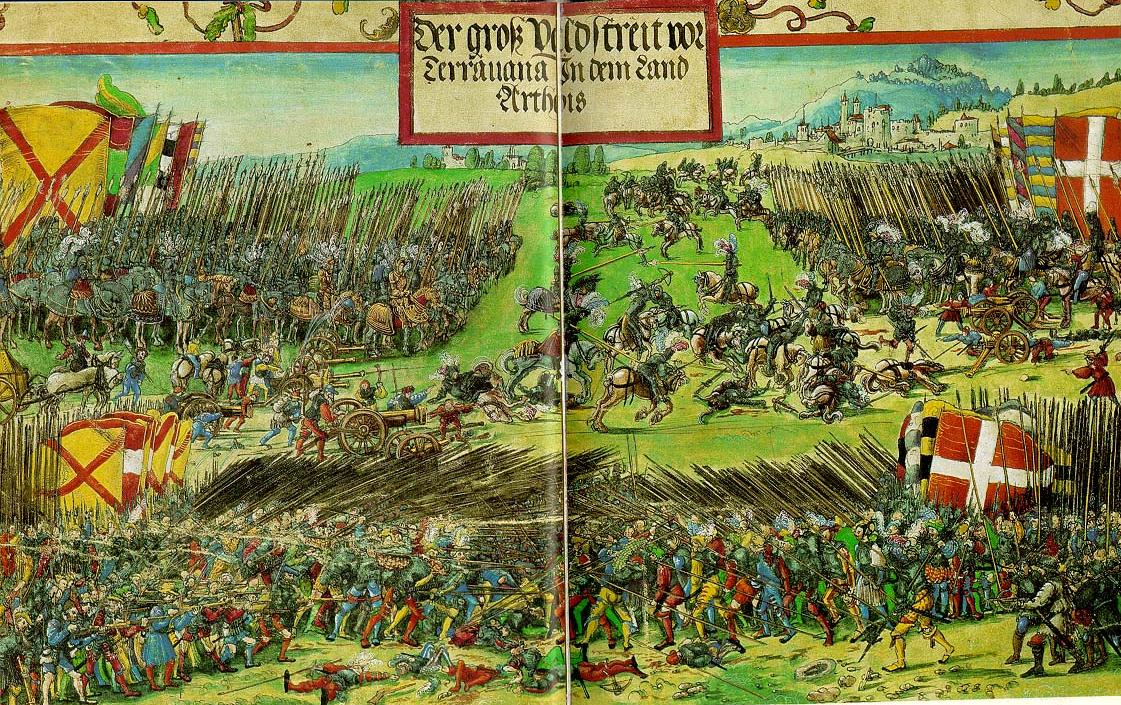
|
|
  |
 |
|
|
You cannot post new topics in this forum
You cannot reply to topics in this forum
You cannot edit your posts in this forum
You cannot delete your posts in this forum
You cannot vote in polls in this forum
You cannot attach files in this forum
You can download files in this forum
|
All contents © Copyright 2003-2025 myArmoury.com — All rights reserved
Discussion forums powered by phpBB © The phpBB Group
Switch to the Basic Low-bandwidth Version of the forum
|

